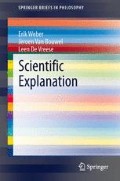Abstract
In this chapter we first summarize the ideas of Carl Hempel, the godfather of this subdomain of the philosophy of science (Sect. 1.2). Then we present the problems that other philosophers have raised in connection with Hempel’s theory of explanation (Sect. 1.3). Subsequently, we clarify how the major research traditions in the field that have emerged after Hempel, can be seen as different reactions to these problems (Sect. 1.4). Finally, we discuss two of these reactions in more detail: Philip Kitcher’s unification account in Sect. 1.5 and Wesley Salmon’s causal-mechanical account in Sect. 1.6.
Access this chapter
Tax calculation will be finalised at checkout
Purchases are for personal use only
Notes
- 1.
An explanans may be true even if we don’t have any evidence in favour of it. And a well-confirmed explanans may be false (which means that our evidence is incomplete and therefore misleading). For these reasons, Hempel introduces two concepts based on the concept of potential explanans.
- 2.
Note that Feynman assumes that the mirrors are flat.
- 3.
Based on research done by Ghent University in the Spring of 2012.
- 4.
We have adapted the notation in the quotation to ours—we also slightly altered Hempel’s original condition, in which he allows for premises not contained in the knowledge system at the time of the explanation, since this doesn’t make a difference to our discussion.
- 5.
Some nice footage illustrating these problems has been produced by the Centre for Logic and Philosophy of Science of Ghent University and is available at http://www.caeits2011.ugent.be/.
- 6.
This is the the probability of the explanandum given the causes mentioned in the explanans.
- 7.
As a historical note, we should add that Kitcher’s account builds on, amends and extends Michael Friedman’s (1974) unificationist account.
References
Cartwright N (1983) How the laws of physics lie. Clarendon Press, Oxford
Dowe P (1992) Wesley Salmon’s process theory of causality and the conserved quantity theory. Philos Sci 59:195–216
Feynman R, Leighton R, Sands M (2010) The Feynman lectures on physics (the new millennium edition). Addison-Wesley Publishing Company, Reading
Friedman M (1974) Explanation and scientific understanding. J Philos 71:5–19
Hausman DM (1998) Causal asymmetries. Cambridge University Press, Cambridge
Hempel C (1965) Aspects of scientific explanation. In: Hempel C (ed) Aspects of scientific explanation and other essays in the philosophy of science. Free Press, New York, pp 331–496
Hempel C (1966) Philosophy of natural science. Prentice Hall, Englewood Cliffs
Hempel C, Oppenheim P (1948) Studies in the logic of explanation. In: Hempel C (1965a), p 245-290 (Originally in Philos Sci 15:135–175)
Humphreys P (1989a) The chances of explanation. Princeton University Press, Princeton
Humphreys P (1989b) Scientific explanation: the causes, some of the causes, and nothing but the causes. In: Kitcher P, Salmon W (eds) Scientific explanation. University of Minnesota Press, Minneapolis, pp 282–306
Kitcher P (1981) Explanatory unification. Philos Sci 48:507–531
Kitcher P (1989) Explanatory unification and the causal structure of the world. In: Kitcher P, Salmon W (eds) Scientific explanation. University of Minnesota Press, Minneapolis, pp 410–505
Salmon W (1984) Scientific explanation and the causal structure of the world. Princeton University Press, Princeton
Salmon W (1989) Four decades of scientific explanation. In: Kitcher P, Salmon W (eds) Scientific explanation. University of Minnesota Press, Minneapolis, pp 3–219
Toulmin S (1958) The uses of argument. Cambridge University Press, Cambridge
Author information
Authors and Affiliations
Corresponding author
Rights and permissions
Copyright information
© 2013 The Author(s)
About this chapter
Cite this chapter
Weber, E., Van Bouwel, J., De Vreese, L. (2013). Theories of Scientific Explanation. In: Scientific Explanation. SpringerBriefs in Philosophy. Springer, Dordrecht. https://doi.org/10.1007/978-94-007-6446-0_1
Download citation
DOI: https://doi.org/10.1007/978-94-007-6446-0_1
Published:
Publisher Name: Springer, Dordrecht
Print ISBN: 978-94-007-6445-3
Online ISBN: 978-94-007-6446-0
eBook Packages: Humanities, Social Sciences and LawPhilosophy and Religion (R0)

